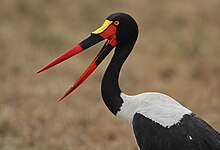Saddle-billed stork
| Saddle-billed stork | |
|---|---|

| |
| Adult male in Kruger National Park, South Africa | |

| |
| Female in Masai Mara , Kenya – irises are yellow
| |
| Scientific classification | |
| Domain: | Eukaryota |
| Kingdom: | Animalia |
| Phylum: | Chordata |
| Class: | Aves |
| Order: | Ciconiiformes |
| Family: | Ciconiidae |
| Genus: | Ephippiorhynchus |
| Species: | E. senegalensis
|
| Binomial name | |
| Ephippiorhynchus senegalensis (Shaw, 1800)
| |
| Synonyms[2] | |
|
Mycteria senegalensis Shaw, 1800 | |
The saddle-billed stork or saddlebill (Ephippiorhynchus senegalensis) is a large wading bird in the
in South Africa.It is a close relative of the widespread Asian and Australian black-necked stork, the only other member of the genus Ephippiorhynchus.
Description


This is a huge bird that regularly attains a height of 145 to 150 cm (4 ft 9 in to 4 ft 11 in), a length of 142 cm (4 ft 8 in) and a 2.4 to 2.7 m (7 ft 10 in to 8 ft 10 in) wingspan.

It is spectacularly
Behaviour
They are silent except for bill-clattering at the nest. Like most storks, they fly with the neck outstretched, not retracted like a
Habitat
At the continental scale, saddle-billed storks preferred protected areas that have a higher extent of open water compared to areas without other storks.[3] Some of these trends may, however, be due to a bias in coverage by ornithologists of safer areas such as national parks and protected swamps that afford easier accessibility and comforts.
Breeding
The saddle-billed storks are solitary nesters, building massive nest platforms that are used repeatedly in successive seasons. Unlike many other storks, these species are often seen in pairs in the nonbreeding season suggesting a lifelong pair bond.[10] They breed in forested wetlands and other floodplains in tropical lowlands. It builds a large, deep stick nest in a tree, laying one to five (typically two or three)[11] white eggs weighing about 146 g (5.1 oz) each. The incubation period is 30–35 days, with another 70–100 days before the chicks fledge, with the young often remaining in the parents' territory until the next breeding season.[12]
Food and feeding
The saddle-billed stork searches for prey by stabbing the bill into the water, catching prey by contact, and in the same way into mud and vegetation.It also hunts by visual detection. In one study with 255 minutes of observation, 71% of successful catches were due to visual foraging, and 29% due to tactile foraging.
Relation to Ancient Egyptian culture
This bird is represented in an
References
- . Retrieved 13 November 2021.
- ^ Elliott, A.; Garcia, E.F.J. & Boesman, P. (2018). del Hoyo, J.; Elliott, A.; Sargatal, J.; Christie, D.A. & de Juana, E. (eds.). "Saddlebill (Ephippiorhynchus senegalensis)". Handbook of the Birds of the World Alive. Lynx Edicions, Barcelona. Retrieved 24 December 2018.
- ^ .
- ^ Borrow, N., & Demey, R. (2013). Birds of Senegal and the Gambia. Bloomsbury Publishing.
- ^ Womack, D. Dallas Zoo, AZA Saddle-billed Stork SSP Coordinator and Regional Studbook Keeper.
- ISBN 978-1-4200-6444-5.
- ^ ISBN 978-0-12-322730-0
- ^ Elliott, A., E. F. J. Garcia, and P. F. D. Boesman (2020). Saddle-billed Stork (Ephippiorhynchus senegalensis), version 1.0. In Birds of the World (J. del Hoyo, A. Elliott, J. Sargatal, D. A. Christie, and E. de Juana, Editors). Cornell Lab of Ornithology, Ithaca, NY, USA.
- ^ "San Diego Zoo file" (PDF). Archived from the original (PDF) on 2011-07-22. Retrieved 2011-01-13. (477 KB)
- ^ Kahl, M. P. "Comparative ethology of the Ciconiidae. Part 6. The black-necked, saddlebill, and jabiru storks (genera Xenorhynchus, Ephippiorhynchus, and Jabiru)." The Condor 75.1 (1973): 17-27.
- ^ Womack, Jocelyn. ""Saddle-billed stork species fact sheet"" (PDF). ASAG. Retrieved 9 February 2021.
- ^ Bouglouan, Nicole. "Saddle-billed stork". oiseaux-birds.com. Retrieved 25 October 2021.
- ^ Gula, Jonah; Mungole, Amukena (2022). "Foraging of Saddle-billed Storks Ephippiorhynchus senegalensis during the dry season in western Zambia" (PDF). SIS Conservation. 4: 10–14.
- ^ a b c Gula, J. (2021). Saddle-billed Stork (Ephippiorhynchus senegalensis), version 2.0. In Birds of the World (S. M. Billerman and B. K. Keeney, Editors). Cornell Lab of Ornithology, Ithaca, NY, USA. https://doi.org/10.2173/bow.sabsto1.02
- ^ Morris, A. (1979). Saddlebill fishing methods. Honeyguide 98:33.
- ISBN 978-1-107-66328-2.
- JSTOR 41431566.
- ^ Janák, J. (2014). "Saddle-billed Stork (ba-bird)". UCLA Encyclopedia of Egyptology 1. UCLA. pp. 1–8.
Further reading
- Barlow, Clive (1997): A field guide to birds of the Gambia and Senegal. ISBN 1-873403-32-1
- Jiménez Serrano, Alejandro (2002): Royal Festivals in the Late Predynastic Period and the First Dynasty. British Archaeological Reports (International Series) 1076. ISBN 1-84171-455-0
External links
- Saddle-billed Stork – The Atlas of Southern African Birds



